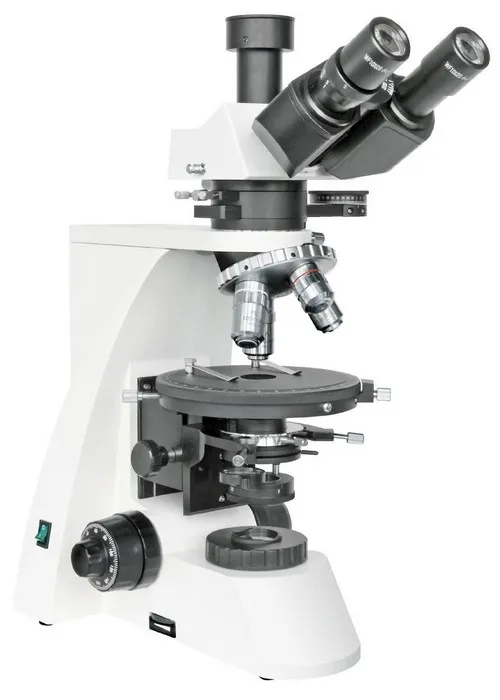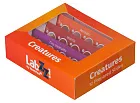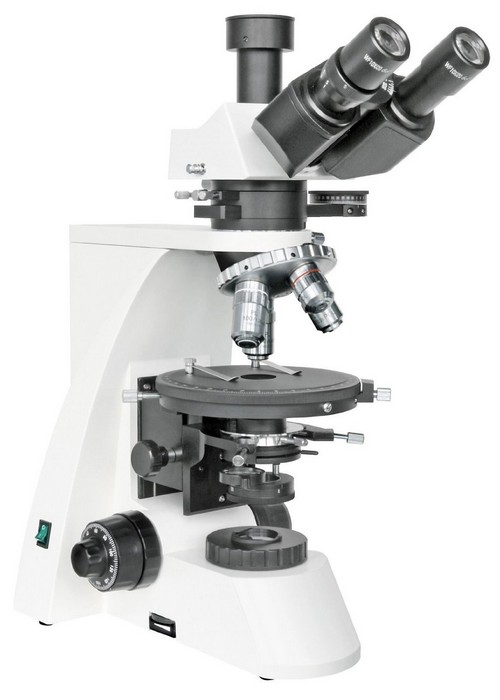Bresser Science MPO-401 Microscope
Trinocular head. Magnification: 40x–1000x
| Product ID | 62570 |
| Brand | Bresser GmbH, Germany |
| Warranty | 2 years |
| EAN | 4007922150307 |
| Package size (LxWxH) | 56x45x31 cm |
| Shipping Weight | 11.5 kg |
In contrast to usual light, polarized light has a preferred vibration plane of the light waves. Polarized light lets be seen anisotropic objects, whose observable properties are depending on the direction, "in a new light": crystals, but also animal hairs, feathers, muscles, nerve fibres and vegetable cell walls, which have a preferred direction of its biomolecules, show structures now, which were hidden in the normal bright field image. Images made by polarized light are often characterized by a fantastic coloring. Polarization microscopes are used particularly in mineralogy, geology, biology and medicine.
In order to change the object's direction in a controlled way, the Science MPO 401 has a round, center-adjustable and full rotatable object stage with degree scale. The illumination and observation unit encloses e. g. the halogen bulb lamp (20W) with dimmer, the field diaphragm (used to achieve the Köhler illumination), the 360° rotatable polarizer (for the production of polarized light), centering implements for the objectives and the analyzer attachment (for the analysis of the polarized light). The analyzer attachment is meant for receiving the 360° rotatable analyzer and optional available sliders (Bertrand lens for conoscopy; quartz wedge, lambda plate and lambda/4 plate used in order to get special colour effects).
The wide field eyepieces (WF10x), which are also optional available, are placed at the trinocular head with an inclination of 30°. They have eye relief adjustment as well as diopter adjustment. The images shown by them are bright, true colored, sharp and rich in details. Apart from the slips and eyepieces, which were mentioned above, the accessories of the MPO 401 contain a dividing eyepiece (WF10x), the Abbe condenser with iris diaphragm, special polarization objectives (4x, 10x, 40x retractable, 100x-oil retractable), filters (blue, ground glass) and immersion oil.
Features:
- 360° rotatable stage with degree scale, adjustable
- Condenser with iris, polarizer, and flip out auxiliary lens
- Adjustable eye relief
- Polarization objective lenses: 4x, 10x, 40x, 100x
- Trinocular head, 30° inclined
- Transmitted light, 12 volt/20 watt, adjustable
- Analyzer incl. quartz wedge, lambda sliders and Amici Bertrand lens
The kit includes:
- Microscope
- 2x WF10x eyepieces
- 4 DIN-objectives (PL4x, PL10x, PL40x, PL100x oil)
- 360° rotatable mechanical stage
- Phasen shifter
- Amici Bertrand lens
- Polarizer/analyzer combination
- Dust cover
- Power cable
| Product ID | 62570 |
| Brand | Bresser GmbH, Germany |
| Warranty | 2 years |
| EAN | 4007922150307 |
| Package size (LxWxH) | 56x45x31 cm |
| Shipping Weight | 11.5 kg |
| Type | biological, light/optical |
| Microscope head type | trinocular |
| Head inclination angle | 30 ° |
| Magnification, x | 40 — 1000 |
| Eyepiece tube diameter, mm | 23.2 |
| Eyepieces | WF10x (2 pcs.) |
| Objectives | 4x, 10x, 40x, 100x |
| Revolving nosepiece | for 4 objectives |
| Stage features | 360 ° rotatable |
| Condenser | Abbe |
| Diaphragm | iris, field |
| Focus | coarse and fine |
| Illumination | halogen |
| Brightness adjustment | ✓ |
| Power supply | 220–240V |
| Light source type | 20W |
| User level | experienced users, professionals |
| Optical scheme | achromat |
| Application | school/educational, laboratory/medical, for applied research |
| Illumination location | lower |
| Research method | bright field |
| Pouch/case/bag in set | dust cover |
and downloads
We have gathered answers to the most frequently asked questions to help you sort things out
Find out why studying eyes under a microscope is entertaining; how insects’ and arachnids’ eyes differ and what the best way is to observe such an interesting specimen
Read this review to learn how to observe human hair, what different hair looks like under a microscope and what magnification is required for observations
Learn what a numerical aperture is and how to choose a suitable objective lens for your microscope here
Learn what a spider looks like under microscope, when the best time is to take photos of it, how to study it properly at magnification and more interesting facts about observing insects and arachnids
This review for beginner explorers of the micro world introduces you to the optical, illuminating and mechanical parts of a microscope and their functions
Short article about Paramecium caudatum - a microorganism that is interesting to observe through any microscope












